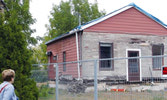Local architect works on high-profile Slave Chapel, Council House heritage projects
BY SHAWN LOUGHLIN
Blyth architect John Rutledge is in the midst of working on two high-profile heritage projects – one in London and another on the Six Nations Reserve near Caledonia.
Hard at work on both at the same time, Rutledge says the similarities between the two projects are almost scary, but they are each of huge cultural significance to two different groups.
The first project, Rutledge says, is the Mississaugas of the New Credit Historical Council House near Caledonia, while the second is the Fugitive Slave Chapel in London. Both are relatively small buildings and the goal with both is the same – to restore the building to its former glory and to expand it to include a museum celebrating the culture of its people.
The Council House, according to a history book produced as part of its revitalization, was first opened in 1882 – in an event at which Sir. John A. Macdonald, the Prime Minister at the time, was expected to speak.
According to the Brantford Evening Telegram, over 2,000 people attended the event.
The centre was called a place for “discussions and decisions” and served a number of purposes over the years. It hosted community celebrations for the return of New Credit’s soldiers from World War I, it was a meeting place for the International Order of Foresters, as the practice hall for the New Credit Brass Band and as a concert hall.
From 1933 to 1938, the hall served as the Reserve’s school after the existing school had burned down and in the 1960s to the early 1970s, the hall served as a small factory in the automotive industry. The Waterloo company Van Dressler produced burlap contours for the bottom of car seats in the house. During this period, eight women reported to work at the house every day.
The building has been an important part of the community’s culture for many years, Rutledge says, so it’s an honour to be involved in bringing it back to vibrant life.
The hope, he said, is that the centre will return to its glory days as a community centre where events can be held, but also that a small expansion can host a museum to help house historical artifacts and displays pertaining to the community and its way of life.
Rutledge says he was contacted by Laura Dent of Stratford, the project co-ordinator, who suggested that he participate in the Request for Proposal (RFP) process for the project. His was chosen and work soon began thereafter.
The building, Rutledge said, looks like it could have been a church or a council chambers due to its architecture, but served as neither.
For a number of reasons, the building needed to be restored and Rutledge was brought in as the right man for the job.
In addition to its importance to the community, Rutledge says the house was home to a number of “firsts” in the First Nations communities of North America, so its importance can’t be overstated. It’s not just an important building to the Mississaugas of the New Credit First Nation, but to First Nations communities throughout Canada and all of North America.
Similarly, the Fugitive Slave Chapel, constructed over 165 years ago, has an important story to tell in the North American narrative and it fell into disrepair, Rutledge is the person being asked to make it great again.
The chapel played host to many fleeing slaves who made their way to Canada via the Underground Railroad, and when it needed work done, the Fugitive Slave Chapel Preservation Project was formed.
For his role in the project, Rutledge has received extensive media coverage, including by the London Free Press.
The project is very similar to his plans for the Council House, Rutledge said, although the Slave Chapel is in much worse condition than the Council House. The hope is that the building can be restored, used as a community and cultural centre and expanded upon to include a museum, celebrating that community’s story.
The re-location of the church, which has already taken place, is also an important part of the story.
The Fugitive Slave Chapel is now located on Grey Street in London, beside Beth Emanuel Church, the church which essentially expanded out of the Slave Chapel.
With heritage buildings his specialty, Rutledge says he feels a special connection to projects like the Council House and the Slave Chapel, and like local restorations he’s taken on, such as the Brussels Library several years ago.
He says he’s committed his life to preserving historical buildings because as generations come and go, the buildings remain to tell history’s stories.
“If we don’t do something to preserve our own history,” Rutledge said, “it’s in danger of being lost forever.”
He said that Huron County has a “good stock” of historic buildings and has been good about preserving them, which pleases him as a Brussels native to know that history isn’t being lost.
He used the Cardno Hall in Seaforth as an example, saying that his grandparents used to go there and dance, but his parents never did. If that building isn’t preserved, he said, that’s an entire generation’s stories that would be lost with no one to tell them.
He also feels that, aside from the historical aspect, some people are quick to jump to the conclusion that a building has outlived its usefulness without looking at the situation objectively.
Very often, heritage buildings can be restored, maintaining that sense of history while keeping a fully-functional building alive, without as much effort and work as is often assumed.
Rutledge has completed the research phase of both projects and is now hard at work making plans ahead of the construction stage, which should begin next year.



